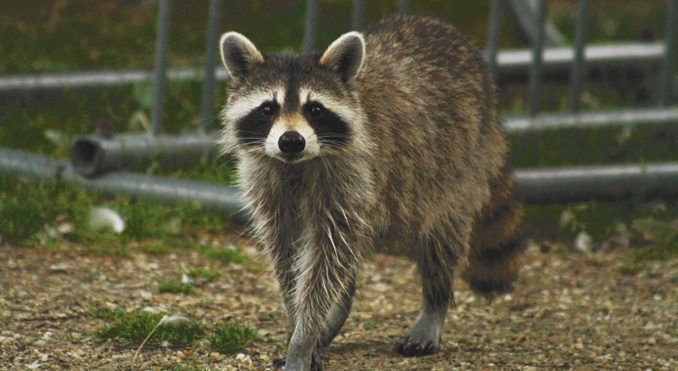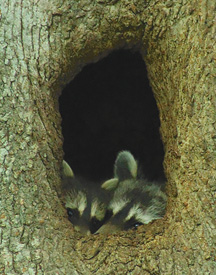
…by Dell Cullum…

Way back in the Black Hills of South Dakota there lives a young boy named Rocky Raccoon. The rest of these masked critters live on the east end of Long Island, well….. not really, but it sure seems like there are a lot here at home. In actuality, there are a lot, and rightly so. Just like the deer, and eventually every wildlife species that exists here on the beautiful east end, they’ve been pushed into shrinking pockets of natural habitat, due to the ever growing human population.
Unfortunately for humans, the raccoon is both smart and resourceful. Slowly taking away their natural habitat (trees) for decades has only forced them to look at YOUR habitat (your home) as if it’s THEIR habitat as well. Look folks, this should be no surprise to anyone. It’s quite simple. You cut down their home to build your house, they make their new home in your attic. It couldn’t be more logical and seems perfectly fair to me.
 Another factor in the raccoon population boom has to do with the fact that we are at the end of an island. Once these critters reach Montauk, they have few options; a long swim, a return trip west, or life in paradise. They tend to choose the latter. After all, during the warmer months the dumpsters are full of wasted food, much of which is surf and turf. The docks become an all you can eat sushi bar, and the vacated summer homes become five star accommodations for raccoons during the colder months. They’ve got it all.
Another factor in the raccoon population boom has to do with the fact that we are at the end of an island. Once these critters reach Montauk, they have few options; a long swim, a return trip west, or life in paradise. They tend to choose the latter. After all, during the warmer months the dumpsters are full of wasted food, much of which is surf and turf. The docks become an all you can eat sushi bar, and the vacated summer homes become five star accommodations for raccoons during the colder months. They’ve got it all.
The results are larger raccoons, with nice clean, healthy coats. The males have the strength to crack even the toughest Mickey’s container, and the females give birth to larger than average litters (the average is 4 to 6, but up to 10 is possible). The more available food, the more young survive. That equals another boost to the population equation.
The downside to the raccoon population issue is the lethal consequences when a specific viral disease is introduced. In this case I’m not referring to rabies, but rather canine distemper. Although not contagious to humans, distemper ravages raccoon populations by quickly spreading throughout their communities. Many consider this to be nature’s way of controlling the population in confined locations such as ours. Whatever the reasoning, let me familiarize you with the signs and facts concerning distemper or what to do when you come across a sick raccoon.
Raccoons can become infected by both Canine and Feline (aka, Cat Fever) Distemper. The most common is the canine type and both dogs and raccoon are pre-disposed to the disease. Unless vaccinated prior to contracting the disease, it means almost certain death. I say almost because there have been a few documented cases where the infected dogs had recovered, but not without permanent neurological damage. In Florida, I personally saw a raccoon subject recover with minimal neurological damage, and live to a fine adult age in a rehab center. It is rare however, and mortality is much higher in juveniles compared to adults.
Distemper lives outside the body for a long period of time (months) and is transmitted through feces, saliva or skin. The very first signs of distemper are flu like symptoms; runny nose, vomiting, diarrhea and watery eyes that soon become conjunctivitis. Much like an upper respiratory infection, it can soon develop into pneumonia. The animal then becomes weak and emaciated in appearance. In the final stages, as the illness impacts the brain and nervous system, the raccoon may wander disoriented in a repeated circular pattern, while others suffer paralysis, most commonly in the hind legs. As the disease overcomes the brain, the raccoon may have seizures. The seizures usually consist of the animal in a sitting position with hands and arms coming together as if clapping, while chattering the teeth. The raccoon eventually falls over as the seizure ends, then repeats itself after a few walks in a tight circle. In the end, the raccoon curls up into a fetal position, falls unconscious, and stops breathing. The entire process usually takes 2 to 3 days, but I’ve seen them hold on for a week.
I’ve both rehabbed and studied raccoons for 30+ years. I feel I know these critters pretty well, however it is still only my opinion when I say, that when the distemper virus attacks the nervous system and brain of the animal, the animal is not in pain. I base this only on observation and the hundreds of raccoons I’ve put down due to the disease. When I do, it is rarely an issue of suffering but rather speeding up the inevitable.
It’s also important to know that raccoons are a rabies vector species, and many of the symptoms associated with rabies are identical to those with distemper, however rabies CAN ONLY be detected through laboratory testing and confirmed no other way. Here on the east end of Long Island we don’t need to be concerned as much in regards to rabies affecting our raccoon population, for the “Raccoon Rabies Prevention Program” was considered a success on Long Island in 2017 after New York State spent 2.6 million dollars in an oral vaccination program. So now, please allow me to put all the rumors to rest in regards to rabies on Long Island. The very first report of a rabid raccoon on Long Island was in Nassau County in 2004. By late 2007 it had increased to almost 70. Cornell University created and distributed (by helicopter) vaccine laced bait into the largest colony locations. A wonderful example of being able to treat wildlife (rather than kill them) to eliminate a disease that impacts humans. BRAVO.
It is not a sign of sickness, to see a raccoon wandering about or through your backyard during the daytime. It’s also not uncommon for a raccoon to sit poolside or even take a swim on a hot summer day. And if you feed your pets outside, you can absolutely expect to get frequent visits from raccoons. The raccoons here on the east end have evolved to a near diurnal status. Food is readily available, domestic pets are mostly restrained off properties and there is usually enough daily disturbances via tree services and construction to keep a raccoon on the move during the day. Still they are most active at night, and that’s when they do their best work.
The raccoon is not a one column creature as their habits differ depending on location. They are magnificent in so many ways and are most interesting right here at home. We’ll talk more about them in the spring. Meanwhile, if you have any issues or questions regarding raccoons or any of our beautiful wildlife species here on the east end of Long Island, please feel free to give me a call at 631-377-6555 and I’ll be happy to chat with you. Here at home, our wildlife is as important as our ocean beaches. We must treat them with care and compassion and protect them from harm.
After all, Wildlife Matters.
~ Dell Cullum
Evelyn Alexander Wildlife Rehab and Rescue: 631-728-WILD
Hampton Wildlife: 631-377-6555

